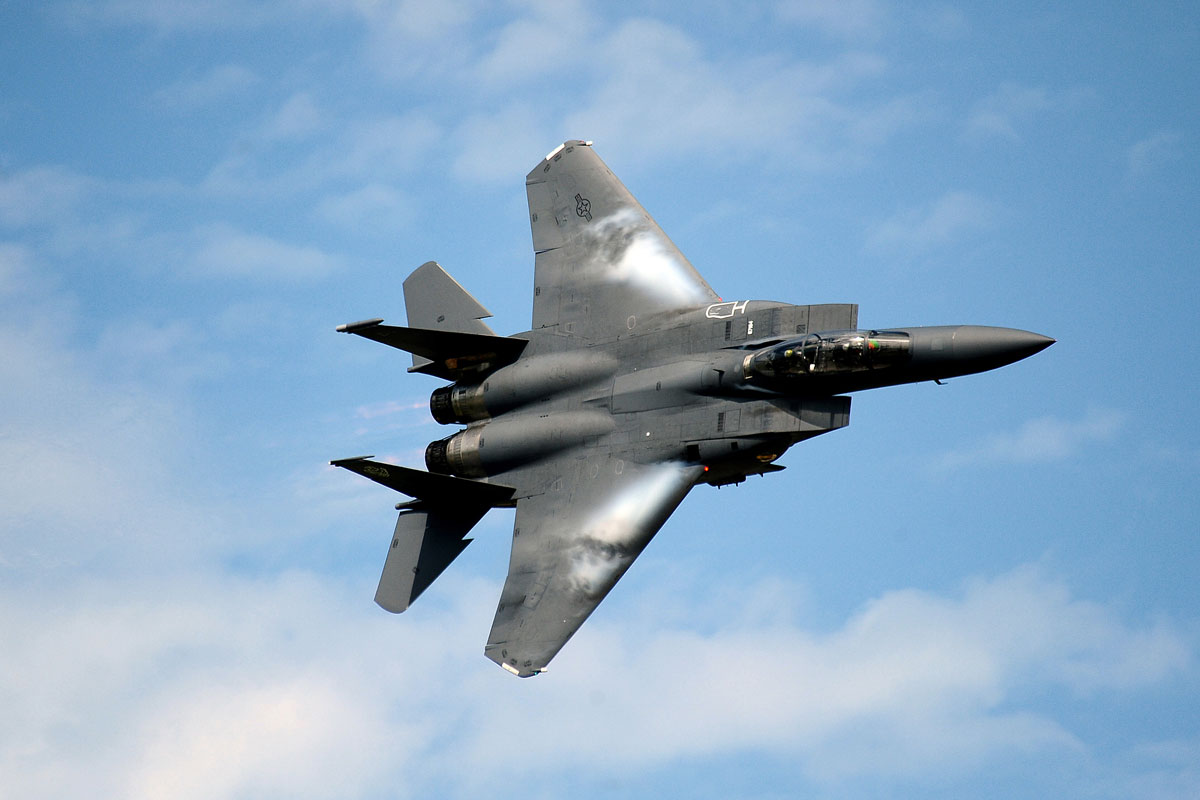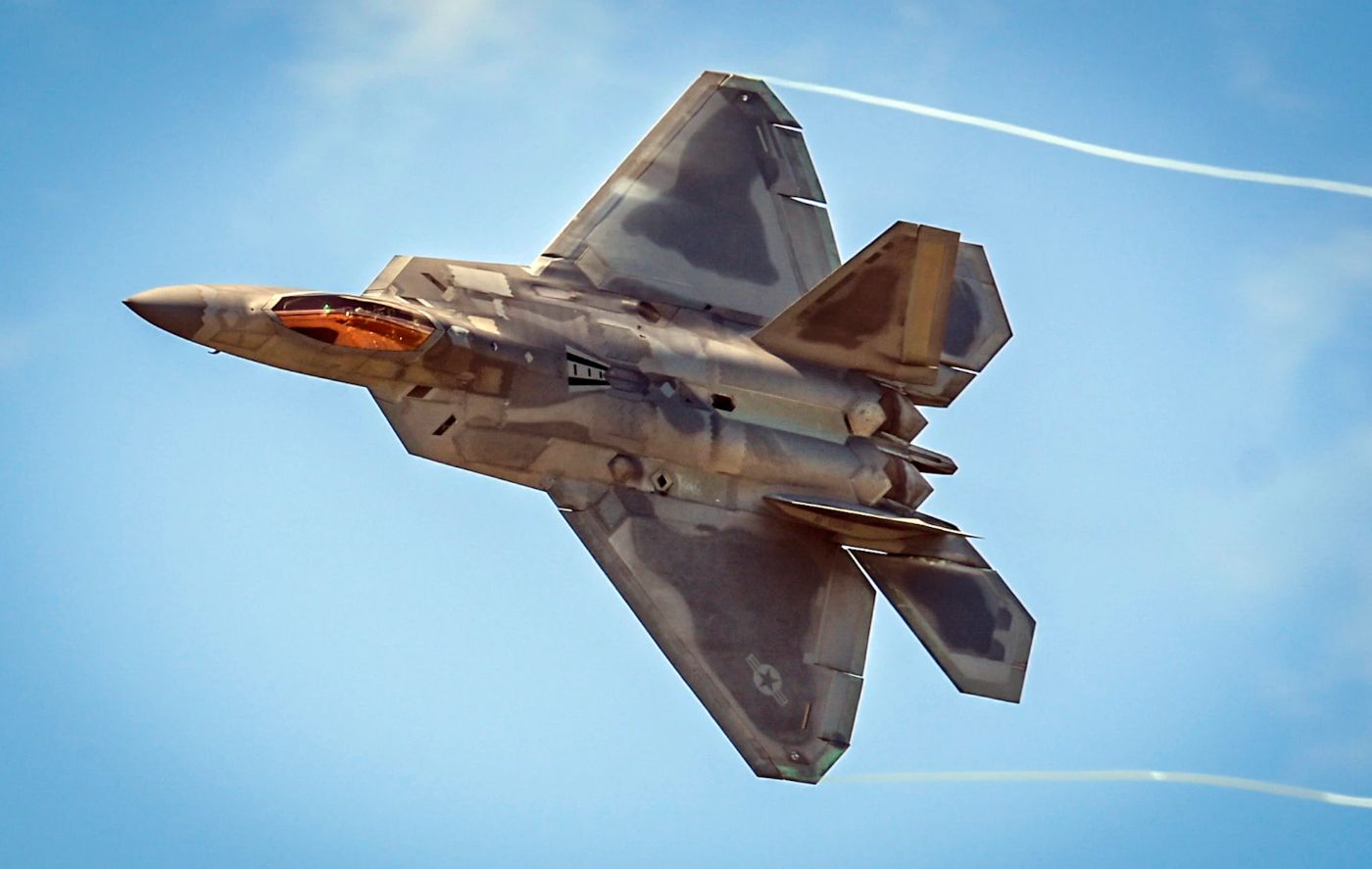On June 17, Lockheed Martin announced that the USAF’s F-22 Raptors had reached the remarkable landmark of 500,000 flight hours. As the US and Lockheed celebrate the Raptor’s continued success, EurAsian Times recollects an incident when the F-22 scored 108 kills against zero losses against powerful fighters like F-15, F-16, and F-18.
For decades, the United States has been at the forefront of designing and developing some of the world’s most formidable fighter jets. These aerial powerhouses, capable of dominating the skies, engaging in air-to-air combat, executing ground assaults, and conducting reconnaissance missions, have remained at the forefront of modern warfare.
Although many of these jets were conceived decades ago, they remain among the most formidable in the world. The US-made F-16s, for instance, have recently garnered significant global media attention due to Russia’s war on Ukraine.
Ukraine is set to receive a fleet of F-16 fighter jets from its Western allies in the coming months. This development has sparked heated debates in the media regarding the potential impact of the F-16s in the ongoing war.
Opinions are divided. Some experts contend that a single type of aircraft cannot decisively alter the course of the conflict. However, many believe that introducing the F-16 Fighting Falcons could serve as a crucial deterrent against Russian aggression.
Regardless of differing viewpoints, the F-16’s enduring relevance and capabilities, which first took to the skies 50 years ago, are undeniable and will pose a massive challenge to the Russian military.
The first F-16 rolled off the production line in 1976, and over 4,600 units have been manufactured since then. At any given moment, day or night, an F-16 is likely soaring through the skies somewhere in the world.
The F-16 entered service with the US Air Force (USAF) in 1978 and has since been adopted by 25 other air forces, spanning countries from Norway to Chile and Morocco to Singapore.
The might of F-16s makes Taiwan confident of deflating the threat of Chinese stealth J-20 fighters. Even Turkey banks on F-16 fighters to continue their regional dominance.
The Legendary F-15 Eagle
The F-15 Eagle stands tall as a symbol of United States air superiority, boasting over 100 victories and an unblemished combat record with zero losses in aerial engagements. With its storied history and remarkable performance, this formidable fighter jet has earned its place as one of the most fearsome aircraft in the US arsenal.
The F-15 Eagle’s origins date back to the late 1960s, when the United States Air Force (USAF) sought to develop a superior air-to-air fighter.
In 1969, after extensive evaluations, the USAF selected the design proposed by McDonnell Douglas, marking the birth of the F-15. This all-weather tactical fighter jet, featuring twin engines, was engineered to outclass any potential adversary.
The initial versions of the Eagle included the single-seat F-15A and the twin-seat training TF-15 variants. Following the maiden flight of the F-15C, the designations were revised to F-15A and F-15B.
These aircraft were powered by Pratt & Whitney F100 engines, achieving a combat thrust-to-weight ratio exceeding 1:1, allowing them to ascend vertically while maintaining airspeed.

The inaugural flight of the F-15A took place on July 27, 1972, with the two-seat F-15B completing its maiden flight a year later. The F-15 entered service in January 1976, quickly establishing itself as a dominant force in the skies.
The latest variant, the F-15EX Eagle II, is an advanced 4.5th-generation fighter jet designed to carry a substantial payload of up to 30,000 lbs of munitions, making it the most heavily armed aircraft in the USAF.
Meanwhile, the F-15’s combat record is nothing short of extraordinary. It has participated in numerous conflicts, including the Gulf War during Operation Desert Shield and the Yemen Civil War, achieving 104 victories without ever being shot down in combat.
While the F-15 was primarily designed for the USAF, it was the Israeli Air Force (IAF) that maximized its capabilities. In 1979, IAF ace Moshe Melnik achieved the first F-15 kill, and since then, IAF pilots have accounted for more than 50% of all F-15 kills.
Israel was also the first to develop and utilize the F-15’s air-to-ground capabilities. One of the most remarkable achievements in the F-15’s history occurred on September 13, 1985, when an F-15, nicknamed ‘Celestial Eagle,’ destroyed a satellite named Solwind P78-1. This marked the first and only time a jet achieved an air-to-space kill.
The F-15 Eagle has continuously adapted to contemporary challenges, maintaining its relevance in modern conflicts. Different versions of the F-15 fighter jet remain in active use by the United States, Saudi Arabia, Japan, Israel, Qatar, South Korea, and Singapore.
F/A-18 Hornet/Super Hornet: A Versatile Mainstay In US Naval Aviation
Since its debut in 1983, the F/A-18 Hornet has established itself as a cornerstone of US naval aviation. It is known for its versatility in both air-to-air and air-to-ground missions. This carrier-based multirole aircraft has continuously evolved over its decades of service, setting standards in combat capability and operational flexibility.
The F/A-18C/D, the current version of the Hornet, boasts an impressive range of nearly 1,800 miles and a combat radius exceeding 1,250 miles. Capable of reaching altitudes up to 50,000 feet and speeds exceeding Mach 1.7 (over 1,300 miles per hour), the Hornet is equipped with a diverse arsenal.
It can deploy a wide array of weapons, including AIM-9 Sidewinder and AIM-120 Advanced Medium-Range Air-to-Air Missiles for air combat, alongside smart bombs and the M61A1/A2 Vulcan 20mm cannon for ground targets.
Originally introduced with variants A/B and later C/D, the Hornet is available in both single- and two-seat configurations, catering to various operational needs.
While some nations and services have phased out the F/A-18 Hornet, including the US Navy in 2019 and the Royal Australian Air Force in 2021, it remains active with the US Marine Corps, Finnish Air Force, Spanish Air Force, and others.

The Hornet’s legacy extends beyond its operational capabilities. It played a pivotal role in shaping naval aviation terminology with the introduction of the “F/A” designation, signifying its dual capability as a Fighter/Attack aircraft.
This designation was inspired by a key incident during the First Gulf War in 1991 when two Navy Hornets transitioned from a ground attack mission to engaging and downing two Iraqi MiG-21 fighters in air combat before resuming their original mission.
Moreover, the F/A-18 Hornet’s success and adaptability laid the groundwork for its successor, the F/A-18E/F Super Hornet. Approximately 20% larger and 15,000 pounds heavier than its predecessor, the Super Hornet incorporates advancements that enhance its range, endurance, and overall combat effectiveness.
With approximately 33% more fuel capacity, the Super Hornet extends its operational range by nearly 40%, ensuring it remains a dominant force in modern naval aviation.
F-22 Raptors Beat All BIG Fighter Jets
The F-16 Fighting Falcon, F-15 Eagle, and F/A-18 Hornet stand as formidable fighter jets, each with its own legacy of excellence. However, one aircraft surpasses them all in aerial combat prowess: the F-22 Raptor.

The F-22 stealth fighter jet is known as one of the world’s most advanced and capable fighter jets. It is designed to achieve air superiority with unparalleled precision.
Its advanced capabilities make it one of the most expensive fighter aircraft ever produced, with each unit costing $150 million, excluding research and development costs.
Its standout features are its low radar profile and a powerful array of weaponry, though many aspects of its avionics remain classified, adding to its mystique and lethality. The F-22 has proven its superiority in various exercises and simulations.
One notable instance is the Exercise Northern Edge 2006, where the F-22 demonstrated its prowess against as many as 40 “enemy aircraft” during simulated battles. Raptor pilots achieved an astounding 108-to-zero “kill” ratio against the best F-15, F-16, and F/A-18 jets, showcasing their dominance in the sky.
In addition to its aerial combat capabilities, the stealthy F-22A has shown its ability to evade and destroy enemy surface-to-air missiles, boasting an impressive 97 percent mission capability rate.
The F-22’s extraordinary performance at Northern Edge earned the aircraft team the 2006 Robert J. Collier Trophy from the National Aeronautic Association (NAA).
This prestigious award, considered America’s highest honor for aeronautical and space development, was presented to the Lockheed Martin Corp.-led F-22 Raptor team for their exceptional work in designing, testing, and operating the aircraft.
The team included industry giants such as Boeing, Pratt & Whitney, Northrop Grumman, Raytheon, and BAE Systems.
Described as “the most efficient and effective fighter in history,” the F-22 Raptor stands out for its exceptional performance and outstanding safety features. F-22’s unmatched capabilities and innovative design have set a new standard in aerial combat, ensuring it remains the apex predator in the skies.
Contact the author at ashishmichel(at)gmail.com




